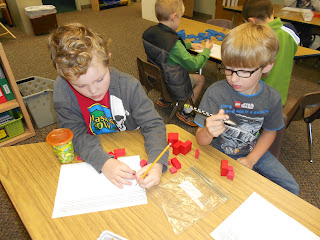I encourage the Sharks to be writing everyday! I focus on getting their ideas down, while working on consistently using punctuation, proper letter formation and correct spelling. Twice a week, the students are writing in their journals. They write about their daily lives, to things that interest them. We have worked on expository writing--giving a topic sentence and supporting details to an opinion or idea. Last week, we starting narrative writing.
This trimester, the Sharks will be using the Writing Process--starting with a prewrite- developing ideas using pictures and phrases; writing a first draft; revising their ideas with partners; editing for mistakes; and finally publishing.
 |
| Reading our stories to our peers during revision helps us to make our story better. |
 |
| ZK and AE are publishing their story using PowerPoint. |
 |
| SB is creating a newspaper for our community. |
 |
| We write in our journal several times a week. |
In addition, our "community" time has been evolving. Today, I observed students bartering goods for services, hiring employees, adjusting inventory to reach more customers, applying sales tax, and adding interest for borrowing money. All these interactions were based on their personal experiences and they are learning from each other.























































